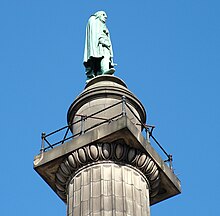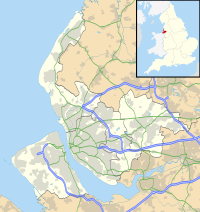Wellington's Column
| Wellington's Column | ||
|---|---|---|
OS grid reference SJ 351 908 | | |
| Built | 1861–65 | |
| Architect | Andrew Lawson George Anderson Lawson | |
Listed Building – Grade II* | ||
| Designated | 28 June 1952 | |
| Reference no. | 1063784 | |


Wellington's Column, or the Waterloo Memorial, is a monument to the Duke of Wellington standing on the corner of William Brown Street and Lime Street, Liverpool, Merseyside, England. It is recorded in the National Heritage List for England as a designated Grade II* listed building.[1]
History
After the Duke's death in 1852, in common with other cities, Liverpool decided to erect a monument to celebrate his achievements. A committee was established to organise public subscriptions, but the money was slow to come in.
The foundation stone was laid on 1 May 1861 by the Mayor of Liverpool. There were further delays during construction of the monument due to subsidence. Although it was inaugurated on 16 May 1863 in a ceremony attended by the Mayor and Sir William Brown, it was still not complete.[6] Reliefs depicting Wellington's victories and the charge at the Battle of Waterloo were still to be added and it was finally completed towards the end of 1865.[2] These delays resulted in its being "a very late example of a column-monument for Britain".[4]
Description
The foundations of the monument are in Runcorn sandstone, the pedestal is in granite, and the column itself is in Darley Dale sandstone. The overall height of the monument is 132 feet (40.2 m), the column being 81 feet (24.7 m) high and the statue 25 feet (7.6 m) high. It stands on a stepped base with a square pedestal. On each side of the pedestal is a bronze plaque; at the corners are bronze eagles joined by swags along the sides. Standing on the pedestal is a Roman Doric fluted column. Within the column are 169 steps leading up to a viewing platform. On top of the column is a cylinder surmounted by a cupola on which the bronze statue of the Duke stands.[2] The statue is made from the melted-down bronze from cannons captured at the Battle of Waterloo.[7] The Duke holds a scroll in his right hand, and his left hand rests on the hilt of his sword.[2]
The brass plaque on the south of the pedestal is a
See also
References
- ^ Historic England, "Wellington Column, Liverpool (1063784)", National Heritage List for England, retrieved 12 April 2015
- ^ ISBN 0-85323-701-8, retrieved 6 August 2011
- ^ Liverpool Daily Post 3 May 1860
- ^ ISBN 0-300-10910-5
- ^ "Link to www.liverpoolmonuments.co.uk/statue/wellington06.html", retrieved 3 September 2013
- ^ "Wellington's Wait". liverpoolhiddenhistory.co.uk. 25 May 2014. Retrieved 5 March 2017.
- ^ ISBN 978-1-906802-90-5


